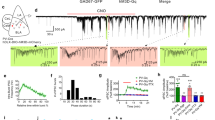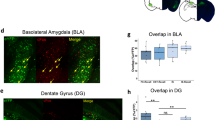Abstract
Changes in emotional state are known to alter neuronal excitability and can modify learning and memory formation. Such experience-dependent neuronal plasticity can be long-lasting and is thought to involve the regulation of gene transcription. We found that a single fear-inducing stimulus increased GluR2 (also known as Gria2) mRNA abundance and promoted synaptic incorporation of GluR2-containing AMPA receptors (AMPARs) in mouse cerebellar stellate cells. The switch in synaptic AMPAR phenotype was mediated by noradrenaline and action potential prolongation. The subsequent rise in intracellular Ca2+ and activation of Ca2+-sensitive ERK/MAPK signaling triggered new GluR2 gene transcription and a switch in the synaptic AMPAR phenotype from GluR2-lacking, Ca2+-permeable receptors to GluR2-containing, Ca2+-impermeable receptors on the order of hours. The change in glutamate receptor phenotype altered synaptic efficacy in cerebellar stellate cells. Thus, a single fear-inducing stimulus can induce a long-term change in synaptic receptor phenotype and may alter the activity of an inhibitory neural network.
This is a preview of subscription content, access via your institution
Access options
Subscribe to this journal
Receive 12 print issues and online access
$209.00 per year
only $17.42 per issue
Buy this article
- Purchase on Springer Link
- Instant access to full article PDF
Prices may be subject to local taxes which are calculated during checkout







Similar content being viewed by others
Change history
17 January 2010
In the version of this article initially published, the gene Ppia (cyclophilin A) was incorrectly written in the Online Methods as p-ia. The sentence “Two house keeping protein genes, Gapdh and p-ia, were tested and showed no detectable change following fox urine exposure, and were therefore used in our experiments” should read “Two house keeping protein genes, Gapdh and Ppia (encoding cyclophilin A), were tested and showed no detectable change following fox urine exposure, and were therefore used in our experiments”. The error has been corrected for the print, PDF and HTML versions of this article.
References
Kandel, E.R. The molecular biology of memory storage: a dialog between genes and synapses. Biosci. Rep. 21, 565–611 (2001).
West, A.E., Griffith, E.C. & Greenberg, M.E. Regulation of transcription factors by neuronal activity. Nat. Rev. Neurosci. 3, 921–931 (2002).
Malinow, R. & Malenka, R.C. AMPA receptor trafficking and synaptic plasticity. Annu. Rev. Neurosci. 25, 103–126 (2002).
Cull-Candy, S., Kelly, L. & Farrant, M. Regulation of Ca2+-permeable AMPA receptors: synaptic plasticity and beyond. Curr. Opin. Neurobiol. 16, 288–297 (2006).
Barry, M.F. & Ziff, E.B. Receptor trafficking and the plasticity of excitatory synapses. Curr. Opin. Neurobiol. 12, 279–286 (2002).
Song, I. & Huganir, R.L. Regulation of AMPA receptors during synaptic plasticity. Trends Neurosci. 25, 578–588 (2002).
Liu, S.J. & Zukin, R.S. Ca2+-permeable AMPA receptors in synaptic plasticity and neuronal death. Trends Neurosci. 30, 126–134 (2007).
Isaac, J.T., Ashby, M. & McBain, C.J. The role of the GluR2 subunit in AMPA receptor function and synaptic plasticity. Neuron 54, 859–871 (2007).
Mameli, M., Balland, B., Lujan, R. & Luscher, C. Rapid synthesis and synaptic insertion of GluR2 for mGluR-LTD in the ventral tegmental area. Science 317, 530–533 (2007).
Sutton, M.A. et al. Miniature neurotransmission stabilizes synaptic function via tonic suppression of local dendritic protein synthesis. Cell 125, 785–799 (2006).
Ju, W. et al. Activity-dependent regulation of dendritic synthesis and trafficking of AMPA receptors. Nat. Neurosci. 7, 244–253 (2004).
Bredt, D.S. & Nicoll, R.A. AMPA receptor trafficking at excitatory synapses. Neuron 40, 361–379 (2003).
Cahill, L., Prins, B., Weber, M. & McGaugh, J.L. Beta-adrenergic activation and memory for emotional events. Nature 371, 702–704 (1994).
Siggins, G.R., Hoffer, B.J., Oliver, A.P. & Bloom, F.E. Activation of a central noradrenergic projection to cerebellum. Nature 233, 481–483 (1971).
Bickford-Wimer, P., Pang, K., Rose, G.M. & Gerhardt, G.A. Electrically evoked release of norepinephrine in the rat cerebellum: an in vivo electrochemical and electrophysiological study. Brain Res. 558, 305–311 (1991).
Saitow, F., Satake, S., Yamada, J. & Konishi, S. beta-adrenergic receptor–mediated presynaptic facilitation of inhibitory GABAergic transmission at cerebellar interneuron–Purkinje cell synapses. J. Neurophysiol. 84, 2016–2025 (2000).
Kondo, S. & Marty, A. Differential effects of noradrenaline on evoked, spontaneous and miniature IPSCs in rat cerebellar stellate cells. J. Physiol. (Lond.) 509, 233–243 (1998).
Cartford, M.C., Samec, A., Fister, M. & Bickford, P.C. Cerebellar norepinephrine modulates learning of delay classical eyeblink conditioning: evidence for post-synaptic signaling via PKA. Learn. Mem. 11, 732–737 (2004).
Sacchetti, B., Baldi, E., Lorenzini, C.A. & Bucherelli, C. Cerebellar role in fear-conditioning consolidation. Proc. Natl. Acad. Sci. USA 99, 8406–8411 (2002).
Sacchetti, B., Scelfo, B., Tempia, F. & Strata, P. Long-term synaptic changes induced in the cerebellar cortex by fear conditioning. Neuron 42, 973–982 (2004).
Scelfo, B., Sacchetti, B. & Strata, P. Learning-related long-term potentiation of inhibitory synapses in the cerebellar cortex. Proc. Natl. Acad. Sci. USA 105, 769–774 (2008).
Hu, H. et al. Emotion enhances learning via norepinephrine regulation of AMPA receptor trafficking. Cell 131, 160–173 (2007).
Seol, G.H. et al. Neuromodulators control the polarity of spike timing–dependent synaptic plasticity. Neuron 55, 919–929 (2007).
Jonas, P., Bischofberger, J., Fricker, D. & Miles, R. Interneuron diversity series: fast in, fast out—temporal and spatial signal processing in hippocampal interneurons. Trends Neurosci. 27, 30–40 (2004).
Rudy, B. & McBain, C.J. Kv3 channels: voltage-gated K+ channels designed for high-frequency repetitive firing. Trends Neurosci. 24, 517–526 (2001).
Geiger, J.R. et al. Relative abundance of subunit mRNAs determines gating and Ca2+ permeability of AMPA receptors in principal neurons and interneurons in rat CNS. Neuron 15, 193–204 (1995).
Fuchs, E.C. et al. Genetically altered AMPA-type glutamate receptor kinetics in interneurons disrupt long-range synchrony of gamma oscillation. Proc. Natl. Acad. Sci. USA 98, 3571–3576 (2001).
Hayley, S., Borowski, T., Merali, Z. & Anisman, H. Central monoamine activity in genetically distinct strains of mice following a psychogenic stressor: effects of predator exposure. Brain Res. 892, 293–300 (2001).
Liu, S.Q. & Cull-Candy, S.G. Synaptic activity at calcium-permeable AMPA receptors induces a switch in receptor subtype. Nature 405, 454–458 (2000).
Sun, L. & Liu, S.J. Activation of extrasynaptic NMDA receptors induces a PKC-dependent switch in AMPA receptor subtypes in mouse cerebellar stellate cells. J. Physiol. (Lond.) 583, 537–553 (2007).
Saitow, F. & Konishi, S. Excitability increase induced by beta-adrenergic receptor–mediated activation of hyperpolarization-activated cation channels in rat cerebellar basket cells. J. Neurophysiol. 84, 2026–2034 (2000).
Soto, D., Coombs, I.D., Kelly, L., Farrant, M. & Cull-Candy, S.G. Stargazin attenuates intracellular polyamine block of calcium-permeable AMPA receptors. Nat. Neurosci. 10, 1260–1267 (2007).
Menuz, K., Stroud, R.M., Nicoll, R.A. & Hays, F.A. TARP auxiliary subunits switch AMPA receptor antagonists into partial agonists. Science 318, 815–817 (2007).
Dolmetsch, R.E., Pajvani, U., Fife, K., Spotts, J.M. & Greenberg, M.E. Signaling to the nucleus by an L-type calcium channel-calmodulin complex through the MAP kinase pathway. Science 294, 333–339 (2001).
Deisseroth, K., Heist, E.K. & Tsien, R.W. Translocation of calmodulin to the nucleus supports CREB phosphorylation in hippocampal neurons. Nature 392, 198–202 (1998).
Liu, S.J. & Cull-Candy, S.G. Subunit interaction with PICK and GRIP controls Ca2+ permeability of AMPARs at cerebellar synapses. Nat. Neurosci. 8, 768–775 (2005).
Gardner, S.M. et al. Calcium-permeable AMPA receptor plasticity is mediated by subunit-specific interactions with PICK1 and NSF. Neuron 45, 903–915 (2005).
Barco, A., Alarcon, J.M. & Kandel, E.R. Expression of constitutively active CREB protein facilitates the late phase of long-term potentiation by enhancing synaptic capture. Cell 108, 689–703 (2002).
Myers, S.J. et al. Transcriptional regulation of the GluR2 gene: neural-specific expression, multiple promoters and regulatory elements. J. Neurosci. 18, 6723–6739 (1998).
Calderone, A. et al. Ischemic insults derepress the gene silencer REST in neurons destined to die. J. Neurosci. 23, 2112–2121 (2003).
Liu, S. et al. Expression of Ca2+-permeable AMPA receptor channels primes cell death in transient forebrain ischemia. Neuron 43, 43–55 (2004).
Rial Verde, E.M., Lee-Osbourne, J., Worley, P.F., Malinow, R. & Cline, H.T. Increased expression of the immediate-early gene arc/arg3.1 reduces AMPA receptor–mediated synaptic transmission. Neuron 52, 461–474 (2006).
Chowdhury, S. et al. Arc/Arg3.1 interacts with the endocytic machinery to regulate AMPA receptor trafficking. Neuron 52, 445–459 (2006).
Perney, T.M., Marshall, J., Martin, K.A., Hockfield, S. & Kaczmarek, L.K. Expression of the mRNAs for the Kv3.1 potassium channel gene in the adult and developing rat brain. J. Neurophysiol. 68, 756–766 (1992).
Sugino, K. et al. Molecular taxonomy of major neuronal classes in the adult mouse forebrain. Nat. Neurosci. 9, 99–107 (2006).
Salkoff, L., Butler, A., Ferreira, G., Santi, C. & Wei, A. High-conductance potassium channels of the SLO family. Nat. Rev. Neurosci. 7, 921–931 (2006).
Rozov, A. & Burnashev, N. Polyamine-dependent facilitation of postsynaptic AMPA receptors counteracts paired-pulse depression. Nature 401, 594–598 (1999).
Ibata, K., Sun, Q. & Turrigiano, G.G. Rapid synaptic scaling induced by changes in postsynaptic firing. Neuron 57, 819–826 (2008).
Kopec, C.D. et al. A robust automated method to analyze rodent motion during fear conditioning. Neuropharmacology 52, 228–233 (2007).
Liu, S.J. & Lachamp, P. The activation of excitatory glutamate receptors evokes a long-lasting increase in the release of GABA from cerebellar stellate cells. J. Neurosci. 26, 9332–9339 (2006).
Acknowledgements
We thank D. Grove and S. Acharjee for scientific input, and M.V.L. Bennett, B. Luscher, P.E. Castillo, L.K. Kaczmarek and M. Whim for helpful discussions and comments on the manuscript. This work was supported by National Science Foundation grant IBN-0344559 and US National Institutes of Health grant NS58867 (S.Q.J.L.) and by US National Institutes of Health grant NS46742 (R.S.Z.). R.S.Z. is the F.M. Kirby Professor in Neural Repair and Protection.
Author information
Authors and Affiliations
Contributions
Y.L. designed and conducted the behavioral, electrophysiological and real-time single-cell RT-PCR experiments, prepared figures and participated in writing the manuscript. L.F. designed and carried out the in situ hybridization assays. I.S. performed the behavioral, real-time single-cell RT-PCR and some electrophysiology experiments, analyzed in situ hybridization data, and prepared figures. Y.T. helped to perform the in situ hybridization assays and participated in data collection and analysis. G.S. provided GAD65-GFP mice. R.S.Z. supervised the in situ hybridization experiments and contributed to the writing and editing of the manuscript. S.J.L. conceived and designed the study and wrote the manuscript.
Corresponding author
Supplementary information
Supplementary Text and Figures
Supplementary Figures 1–4 and Supplementary Tables 1–3 (PDF 1502 kb)
Rights and permissions
About this article
Cite this article
Liu, Y., Formisano, L., Savtchouk, I. et al. A single fear-inducing stimulus induces a transcription-dependent switch in synaptic AMPAR phenotype. Nat Neurosci 13, 223–231 (2010). https://doi.org/10.1038/nn.2474
Received:
Accepted:
Published:
Issue Date:
DOI: https://doi.org/10.1038/nn.2474
This article is cited by
-
Intrinsic plasticity of Purkinje cell serves homeostatic regulation of fear memory
Molecular Psychiatry (2023)
-
Inhibitory neurotransmission drives endocannabinoid degradation to promote memory consolidation
Nature Communications (2020)
-
Molecular layer interneurons in the cerebellum encode for valence in associative learning
Nature Communications (2020)
-
Cerebellar molecular layer interneurons are dispensable for cued and contextual fear conditioning
Scientific Reports (2020)
-
Noradrenergic Modulation on Dopaminergic Neurons
Neurotoxicity Research (2018)



